Treat Yourself to A French Dining Experience At Mon Ami Gabi (Paris Hotel Casino – Las Vegas)
Mon Ami Gabi is a classic French bistro located at the Paris Resort and Casino on the Vegas strip. “Mon Ami” means “my friend” in French and “Gabi” refers to owner and chef Gabino Sotelino. Since the first restaurant’s opening in June 1998 in Chicago, the bistro strives to serve traditional French favorites in a setting that makes you feel like you’re right in the heart of Paris. Prepare to have your taste buds exploding with all kinds of different flavors with some of your favorite french dishes like onion soup au gratin, country style pâté, escargots, beef bourguignon, trout amandine, crêpe, quiche and, of course, steak frites which is an absolute must, as are the desserts like the blissful apple tarte tatin and the decadent Profiteroles.

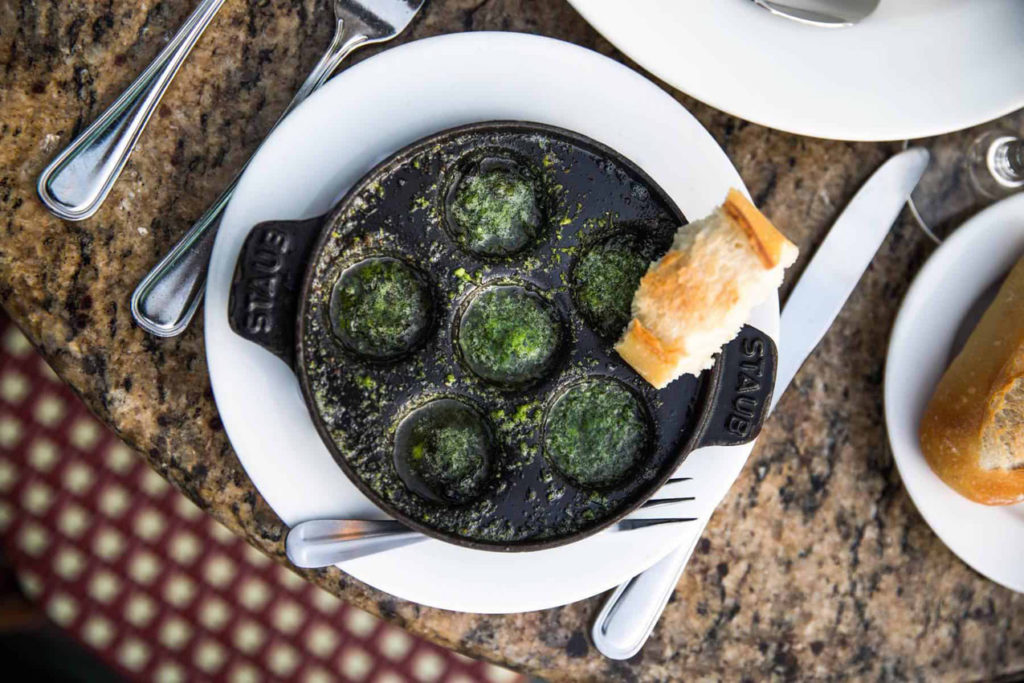
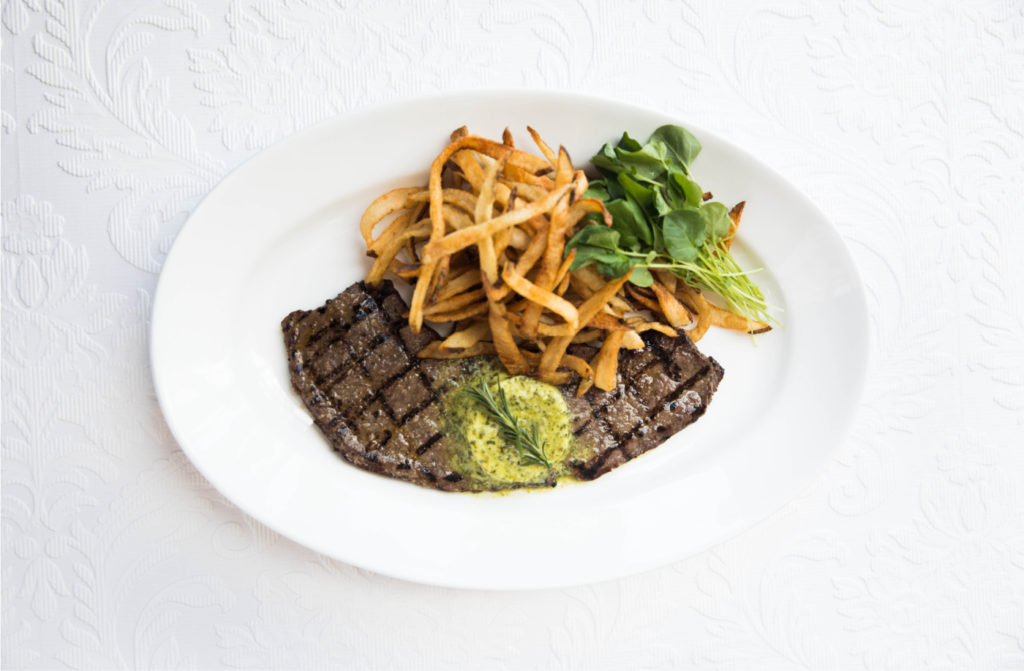
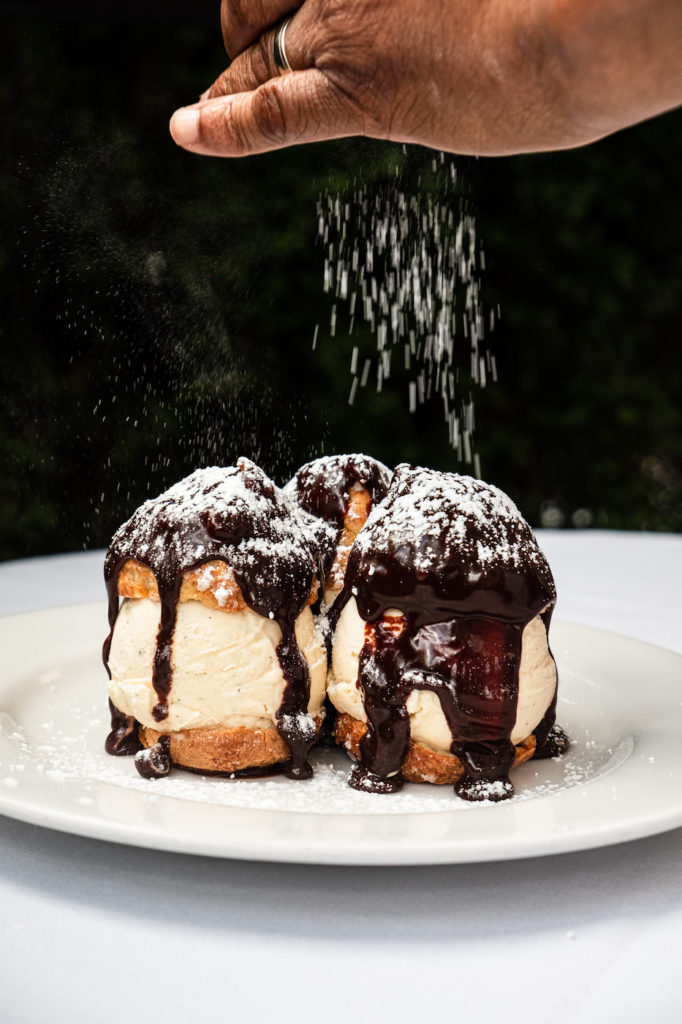
One of my favorite restaurants ever, and a must visit whenever I go out and about on the Strip of Las Vegas, serving breakfast, brunch, lunch and dinner, it is always the right time to stop by Mon Ami Gabi.

French Quarter Magazine recently talked with Vincent Pouessel, the Mon Ami Gabi’s Executive Chef who joined the Lettuce Entertain You family in 2016. In a conversation that flowed over the course of hours, Vincent talked about his career, his kitchen discipline he have learned from other chefs, from the people who had a huge impact on him, the importance of someone’s help pushing the boundaries, his passion for cooking and his inspiration, what is doing well on the menu at Mon Ami Gabi, and finally his state of mind been since the pandemic.

Photo Credit: French Quarter Magazine Collection
How did your passion for cooking begin?
Like many chefs and lots of people who work in the kitchen, I think it goes very far back to their childhood. For me it was quite simply and almost even indisputably, from my maternal grandmother. In Brittany, where she had a small business and she made buckwheat pancakes (what we call crepes in the United States).
Did she have a creperie?
Yes, it wasn’t really a creperie in a sense because we didn’t have a retail shop. It was rather a production room where she made crepes that she would distribute in shops. She sold them either as takeout or she’d deliver them around town, but she didn’t have a restaurant.
They were plain crepes that you could serve at home… At the time in Brittany, it was a pretty common thing: people went to the bakery or to their fruit and vegetable shop where they could always find a stack of crepes that a local artisan had made. Customers ordered or took anywhere from 6 to 10 or even 12 crepes with them.
Approximately what year was that?
It was in the 70’s and 80’s. My grandmother made crepes every day. I remember the smells, the aromas, and eventually over the years I would give a little helping hand folding the crepes up, wrapping them in packs of twelve, and so on. We also had a cook who prepared different dishes, recipes used for the family’s dinners, so I was always, more or less, exposed to the kitchen.
Was it during the holidays, on a daily basis, or just on the weekends?
It was done on a daily basis! When I came home from school, there was always something simmering on the stove in the kitchen. All the aromas, the smells, the combination of different ingredients melding together, the onions, the shallots, which had browned in butter to make a Madeira sauce… I was exposed to all of this on a daily basis when I was a child.
So not just crepes then?
Lots of local cuisine, it was pot-au-feu, hen-au-pot, dishes that cooked for a good part of the day, which lent to a deliciously scented house.
Did your grandmother live near you?
She lived with us, with my parents and I. She cooked for the whole family. It was precisely when it started to make sense, without necessarily realizing it at the time, since it wasn’t yet ingrained in my mind to tell myself that I was going to be a cook.
Can you possibly give us a particular striking memory?
Yes, my grandmother was a master at making madeleines. She made madeleines which were absolutely incredible. I obviously kept this recipe and many others, an easy thing to do with all the good products from Brittany, especially the dairy products, good milk, good butter. At the farm in my village, we’d go to fetch milk, I’d even dare to say that it was almost fresh from the cows udder, milk which had just been drawn a few hours before. I have distinct memories of my grandmother who used to boil the milk to separate the curds from the whey without us actually having lived in the Middle Ages obviously (laughter). Boil the milk, but for what exactly? To recover the cream! We used the cream for all kinds of applications, whether for sauces or to put in pastries, or in coffee… It was the purest form of cream from unpasteurized whole milk from the farm of the village.
I tasted your delicious tarte tatin. Is this a recipe from your grandmother?
No, not directly because she was making an apple pie which was a slightly different variation, but it’s the recipe of one of my aunts who was more suited to making good tart tatin’s. Here in Las Vegas, being a French bistro, the tarte tatin has really been on the menu since the day the restaurant opened 20 years ago. At Mon Ami Gabi, the tarte tatin is a prime example of a classic dessert.
Can we then find your grandmother’s madeleines at the restaurant?
Indeed, we do them from time to time upon special request. It’s actually the secret dessert of the restaurant. Most waiters know that I always have a pastry bag full of madeleine batter on hand in the kitchen. So if it so happens that there’s a customer who appreciates them and requests them from us we can make them right away. They only take six minutes to bake.
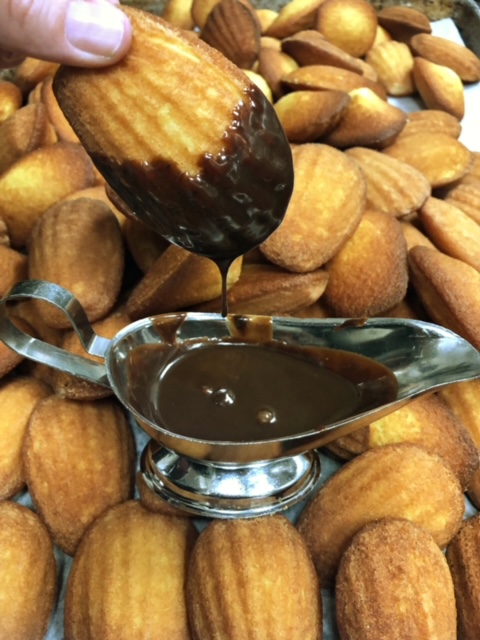
Is this the recipe for real Proust madeleines? With a touch of lemon or orange zest?
Yes, for real, with salted butter and lemon zest. We’re not going to reveal all the secrets of course, but my grandmother used a little lemon zest because it was the most common citrus fruit. At Mon Ami Gabi, we add a little lime zest because I find that it brings a certain freshness to it. It’s slightly different from a lemon, but a lime brings a little exotic touch to the madeleine. But to close the subject, the main thing really is that the madeleines need to be baked in a madeleine mold for six or seven minutes. The hump of the madeleine must really be prominent, that is, in fact, the whole secret behind the madeleine! It should be eaten hot, warm and fresh out of the oven. We serve them in folded linen with a small ramekin full of chocolate sauce to dip them in. That is the ultimate symbol of “decadence.”
How do you get accepted to come on board as the chef at Mon Ami Gaby?
For me, it came quite naturally, as the restaurant has been in Las Vegas for over twenty years, right around the time I moved here. Also thanks to my career and my training in a hotel school in Brittany (a classic and rather rigid Catholic hotel school), I had nuns as teachers who gave me a good foundation (which I certainly do not deny). There was a lot of rigor and a lot of discipline. The success rate of the young people who received training at this hotel school was very high. Subsequently, the people I went to school with have had quite exceptional careers for the most part. I still remain in contact and keep in touch with a lot of the people that I went to hospitality school with and most of us have done well and have all had great careers. At the same time, it’s quite simply a form of pride because it’s the environment in which I was brought up in.
This education has trained you to be a disciplined and rigorous leader in your work. Then you went overseas and came to Las Vegas in 2001?
I think I was just looking for something different, like most young people who move abroad, I was 30 years old, I was in Paris and there was just this kind of feeling of comfort and ease… I had a job, I was working at the Eiffel Tower, at restaurant Jules Verne, so I really had no reason to leave Paris except that I was looking, I think, for something exotic.
And ultimately, you found another Eiffel Tower…
One day in the mid-90s, I saw a chef land a job in the kitchen at Jules Verne restaurant. It was Chef Jean Joho. To be honest, he’s the chef who now runs the Eiffel Tower restaurant here in Las Vegas at the Paris Hotel. Jean was a friend of Alain Rex, the chef who at the time ran the Jules Verne restaurant at the Eiffel Tower in Paris. He came, in fact, to soak up information at Jules Verne and the two other restaurants at the Eiffel Tower to use it as inspiration for the Eiffel Tower here in Las Vegas. Many years later, we talked about it again, he remembered that he had passed by the Eiffel Tower in Paris and I remembered Jean very well at that time. Being here, at the Eiffel Tower in Las Vegas, was pretty “fun.”
Do you have any favorite products at Mon Ami Gabi?
For the most part, we try to use as much produce as possible that comes from the west coast of the United States, the closest place that produces fruits and vegetables. A few products also come from further away. Here in Las Vegas, there’s a term in English known as “hydro rolling,” where producers use mostly soilless crops. These are herbs such as basil, chives, etc… so there are several producers in Las Vegas who are able to provide us with aromatic herbs. Usually everyone that comes to Las Vegas thinks that we only produce fun, happiness and good memories. To set the record straight, as ridiculous as it may sound to have an herb industry here in Las Vegas, it does exist and it’s amusing to highlight it.
What about fish and meat?
Most of the meat we use comes from Illinois, from around the Chicago area, because Lettuce Entertain You, which is Mon Ami Gaby’s parent company, is based out of Illinois. There’s exceptional beef production coming out of the American Midwest as you can only imagine, a very high quality product. For all of those who enjoy fish we have a trout on the menu that comes from the Idaho River, so not too far from Nevada. Salmon comes in from the Atlantic, from the Northeast of Canada, above Prince Edward Island. This is where we source our salmon and most other products. Everything that is poultry and pork comes from California (Santa Monica, Santa Barbara). Depending on the season, for example, the Halibut and other fish can come from Alaska, the oysters that we have at the moment come from Vancouver, therefore bordering on Alaska, and all our dairy products come from California. All of this, (the fish, the meat, the poultry)… is of course refrigerated on planes and arrives very quickly to Las Vegas? Yes, I place my order from producers who are based out of Los Angeles or the San Francisco Bay area at 4pm in Las Vegas and we have it delivered the next morning by 6am. It’s a very short timeframe.
Are there any products that come from France?
I’d say yes of course, because evidently it’s done out of pride, all of our dried goods (our vinegars, mustards, pickles), all these things come from France. These are the products we’re most comfortable with, we have a closer relationship with these products. We know them better. I know their properties, their fragrances, their tastes, so for me it makes sense to use them. Then we also have products like lentils that we bring over for different seasons, for a winter menu for example, they come from France, from Le Puy. Obviously in the same way that we have coconuts from Paimpol, in an almost logical way we don’t try to find substitutes. Fleur de sel, for example, is Guérande salt, but today almost everywhere on the planet, in every bistro or brasserie one can provide itself with Guérande salt. We can import or bring in just about any product and now that it’s 2020 it’s almost as easy to find a good fleur de sel or a good chocolate to make chocolate mousse with in Las Vegas as it is in Paris or Lyon.
Even with the current health crisis?
Yes, because we work with products that are already established and present on the American market, on the international market, but particularly in the United States for a very long time, so ultimately all that is chocolate, for example, we use chocolates that come from France. We go through intermediaries, companies that have sufficient stocks here. We use Coco Barry for example. We work with Valrhona, which is really the benchmark in terms of chocolate products. All our glucose syrups come from France as well as the fruit purees we use to make our sorbets. We’re not necessarily looking to have nothing but French products at all costs but we do want more products that are unique to us and with which we’re comfortable working with.
Can you tell us about a dish that you particularly like to prepare and a chef’s secret?
Well, right off hand I’d have to say that the dishes that I really like to prepare are slow cooked meals, or in any case, meals that are simmered for a long period of time or dishes that are braised. Immediately what comes to mind would be the coq au vin. It strikes me as one of the most iconic dishes that we serve during most of the winter season, we have it on the menu where we offer it as a “special menu” throughout the year however.
So can we find coq-au-vin in summer?
No, it’s still a winter dish. In winter, there’s a very good chance that you’ll find the bourguignon, the lamb shank with either fresh pasta, a good mashed potato or polenta, but these are typically fall and winter dishes after all. During the summer the menu changes, in the summer we like to work with seasonal products, we make a nice tomato salad with feta cheese that comes from Corsica, so you once again see French products. We make a good “salade fromage” which is absolutely wonderful. We also offer a nice salmon steak with a lovely pea puree. It’s truly a spring/summer affair. We add a touch of melted butter, and a fresh squeeze of lemon, it’s slightly acidic and so very light. It’s quite simple after all, but it’s a dish that reminds us of summer. We also serve a delicious ratatouille during our spring and summer months.

And for our American friends, what do you think they’d like to eat in the fall?
We have grandmother’s roasted chicken, which is truly a timeless recipe and a big part of the classic French repertoire. This is a whole chicken roasted on a spit rotisserie style, of which we then debone the carcass and serve it with the white meat of the chicken breast facing up. It’s roasted to perfection, it’s juicy, beautiful, and the same goes with the chicken thighs and the drumstick. We stuff a little bit of garlic and thyme under the skin before we roast it. There’s a ton of flavor in this chicken. We serve it with garlic mashed potatoes and a side of sauteed mushrooms and bacon lardons. It’s the ultimate fall dish. People love it. Americans will like it because it isn’t only French people who come to dine at Mon Ami Gabi… No, no, at Mon Ami Gabi, the standard dish is steak frites. Steak and fries with a buerre maitre d’hotel or what we call a classic butter here in the states, which contains parsley and melted shallots. First we cream the butter and then we add the parsley and shallots, then we roll it and make small coils, we then refrigerate the butter and when it comes time to serve the steak we cut off a nice piece of this compound butter and place it onto the freshly grilled steak, it’s served with crispy fries at will. I would say it’s the most classic dish in the restaurant, it’s the best seller as they say in English.
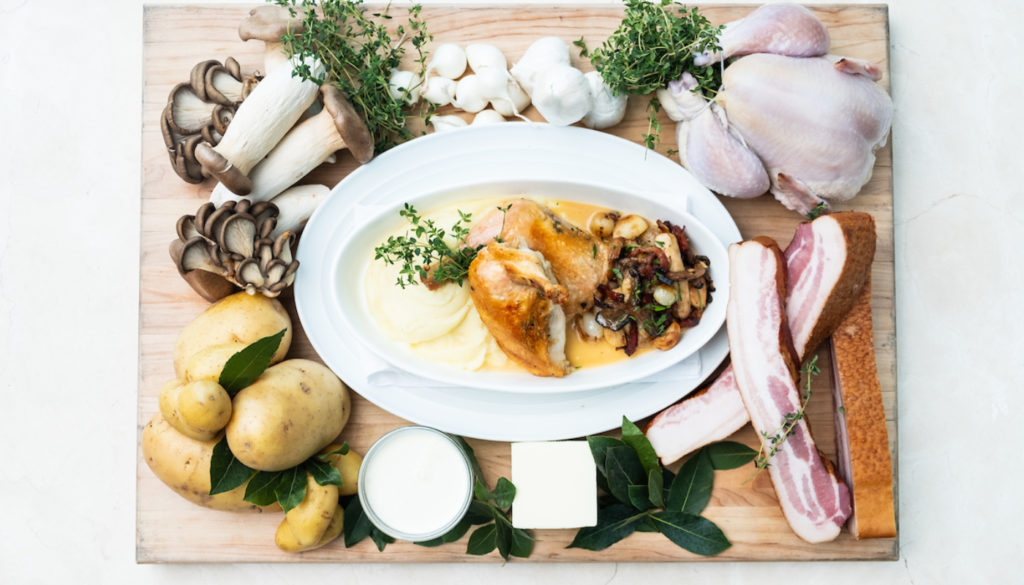
A chef’s secret…
A secret… I would say maybe our fries because the fries are really the most legendary ingredient in the restaurant and I can tell you that ours are made from fresh potatoes. Our fries are homemade, we cut them on a mandolin by hand, we don’t use a machine, they’re washed in basins of water to remove the starch, that’s part of the secret. We remove the starch from the potato as much as possible by washing them, stirring them several times and then we parcook them, we blanch them in an oil bath for the first time so that the potatoes are tender and just when your steak is almost done cooking and comes off of the grill, we plunge the precooked fries in the hot fryer oil again just for a few seconds, stirring them vigorously. We take them out of the fryer, we season them with “La Baleine” salt, a fine salt which is iodized to perfection. We’re not going to advertise, but it’s a good local salt. Sprinkled on the plate of fries, it’s delicious and I think that is probably the biggest secret we have.
Now a question that might be a little bit difficult for you, let’s make it short, two French chefs that are inspirations to you? Let’s limit ourselves to just two.
That’s probably the most difficult question to answer because there are so many. I was going to say, the people I’ve already worked with obviously. Within terms of my career, I’d say the chef who I admire most and who has laid the groundwork for what we do on a daily basis is Paul Bocuse. There’s no need to even beat around the bush, he really is the most prominent figure for a cook like me who has had a rather classic career after all. Other than him, because I’ve been in Las Vegas for twenty years, I’d have to say that there are really two other people, two chefs who are on an equal basis since I’ve worked for this chef for many years. He’s an American who is very well known and recognized, the iconic Charlie Palmer. Americans usually ask me, “Who is your mentor? Who is the person in the kitchen who really made a mark on you, who influenced you, who touched you… etc.?” Again, it’s Charlie because I worked with him for 13 years in his kitchens. The other chef with whom I also had the chance and the pleasure to work with was Daniel Boulud, another Frenchman who, for me, has had the most successful career as a French chef in the United States. Someone like Daniel Boulud who really set the standard for French cuisine in the United States. Working for someone like Daniel was very important to me. It’s something I could never disassociate myself from, the precision, the expertise, the technique, the standards that someone like Daniel Boulud represents. He influences all the people who have worked for him, he pushes you to search for the holy grail, for perfection, knowing that it’s obviously not possible to achieve perfection. Daniel Boulud, for me, is truly the benchmark for our industry in the United States. It allowed me to self-assess all that I had done all those previous years and at a time when I arrived in one of his kitchens with a lot of humility and questioning, finally a good boost of confidence.
Has it allowed you to push your limits in some way?
Absolutely, it’s almost allowed me to take on another dimension. So I think it’s really these people who have influenced me the most. Of course, beside that, there are thousands that I could’ve mentioned.
How’s your state of mind been since the pandemic?
I would say that in this worldwide catastrophe that it’s truly an ordeal that we’re all going through, an unprecedented crisis putting all of us under a lot of pressure. We’re the first generation to have really gone through such a cataclysm on a global level. We’re fortunate enough to be able to continue to exercise and to cook every day knowing that the restaurant is open at 35% capacity, knowing that we’re in Las Vegas, a city where business hasn’t fully resumed but at least we’re in business even if it isn’t at the same level of activity that we had been prior to Covid-19. My first feeling was that I was lucky. Many thanks to Lettuce Entertain You and the people I work for, Richard Melman, the founder and creator of this company, but also the “leadership” of the company, our president, R.J. Melman, who is Richard’s son. I think they really knew how to negotiate this very delicate turn of events due to Covid-19. Remembering the setting of the restaurant and the hotel, and everything that has happened to us over the course of the past few months, we’ve been slower than usual so this is an enormous benefit because it allows us to be able to really engage with the staff here at our level and try to get a message of comfort and support.
Welcoming customers properly…
Exactly, everything has been done so that the staff can be comfortable and ultimately have a level of confidence in what we’re doing and so obviously this is felt by our customers, they see it. Things are done in a very professional way, social distancing and space barriers, the health protocol that had to be applied to the restaurant, it’s not negotiable. It had to be put in place at the highest possible level, even above what the authorities asked of us, so that the customers continued to come with confidence.
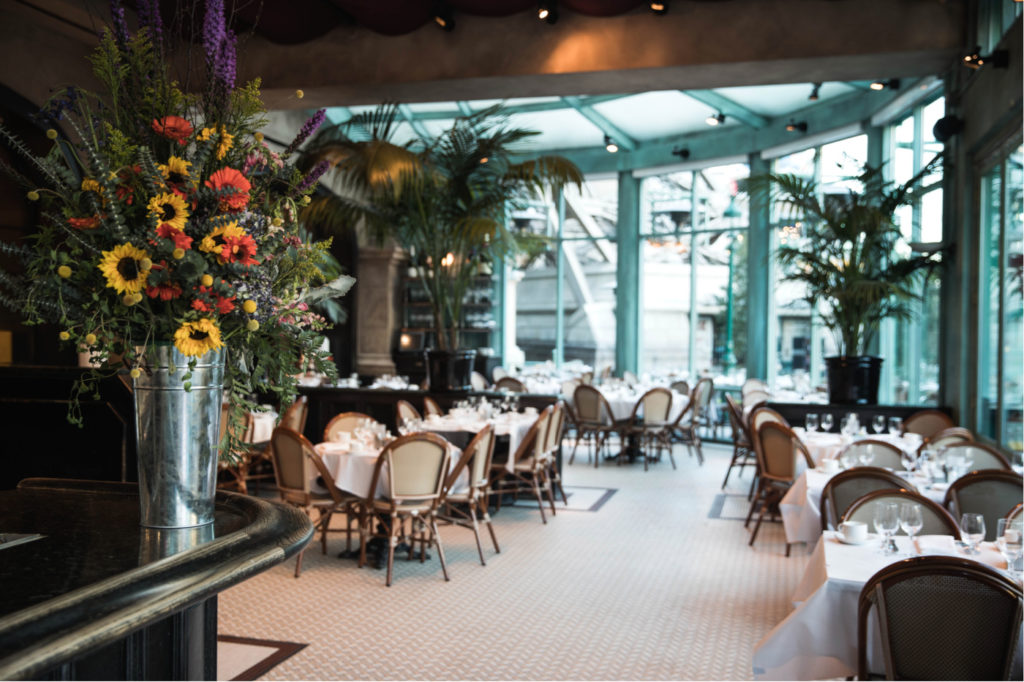
I saw that the terrace is open as well as the main dining room, on the other hand, the interior rooms are not yet open because you also have to follow the 35% capacity and it’s actually pleasant to find oneself in a bright room with high ceilings, one feels good and with the windows there’s a lot of natural light, one really feels confident to come in for brunch, lunch or dinner.
I’m delighted to hear you say this because it’s a big step in the right direction. Thank you very much because it is the Holy Grail, the essential goal is that our customers keep coming. We’ve been an established restaurant for 21 years now, we have a local Las Vegas clientele who come in to visit us once or twice a week but we also have a lot of tourists who come from California for the weekends. We have high quality products that are of extreme quality, cooked with passion and kindness. I hope this is encapsulated into our finished dishes.

It’s felt on the plates, it’s felt by the staff, and it’s definitely felt in your restaurant…
Yes, after all, it’s up to us, the leaders, to engage everyone on the same route to the same destination. For us, we’re waiting for a return to normality, obviously this is the big question of when, no one really has a clue, we just hope that things will improve in the upcoming months, that travel restrictions be lifted and that we can find our international clientele again. We’re really looking forward to them because the business at the moment is more of a domestic business, it’s people who come from the United States or neighboring states, but we can’t wait to meet our colleagues from France who come to take a stroll on the west coast and visit Las Vegas.
Last question, can we order take out?
Yes, of course, this has always been available. We’ve always been able to offer take-out meals. Usually the order is placed by telephone, the receptionist takes the order which is sent to the kitchen, the prepared meals are then put into take-out boxes and according to what has been decided with the customer, either they come to pick it up at the reception area of the restaurant where the hostesses are, or it is through “grubhub,” or any of the other take-out options that are available.
This article was translated in English by John Wilmot.















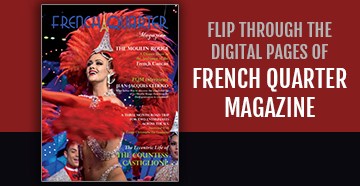





Fantastic read! This article does an excellent job of breaking down what smart homes are and how they’re transforming modern…